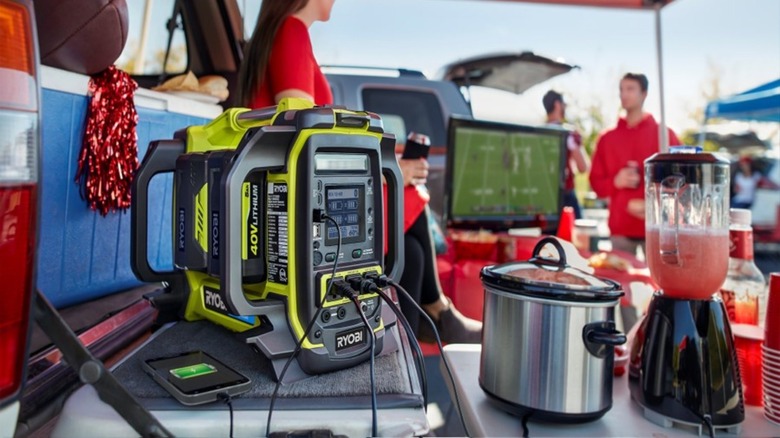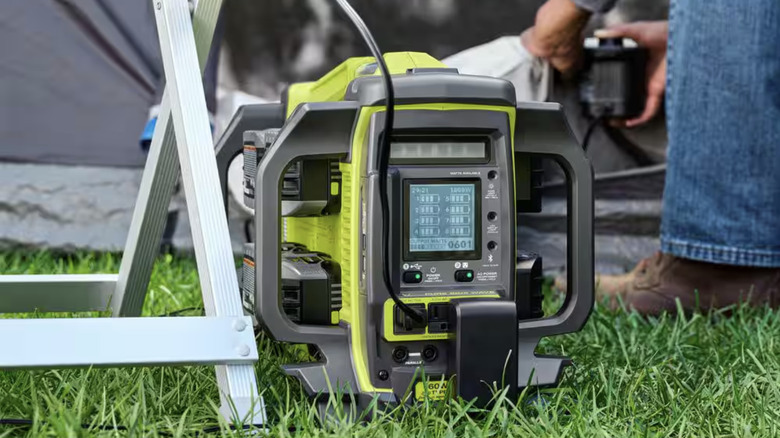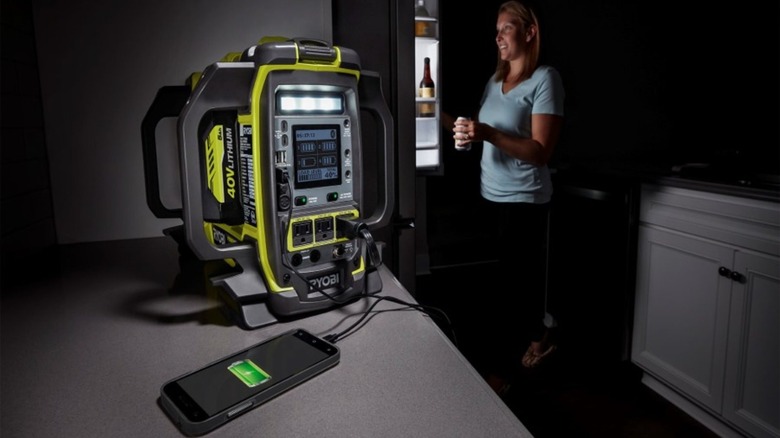Which Ryobi Inverters Are Pure Sine Wave & How Do They Differ From The Others?
If you're looking for a power source within the Ryobi battery line, you'll find yourself facing many decisions like how many watts you need it to handle, and which batteries it takes. If you're already invested in a specific battery line, the choice will become a bit easier — some power stations take 18V batteries, while others take only 40V batteries.
However, if you're still deciding, you'll want to do extra research to ensure you're getting exactly what you need. In terms of power stations, Ryobi has inverters that can do the job. However, the term "inverter" is not a one-type power source — they come in different sine waves that produce different types of energy.
It's important to note that there is a difference between inverters and generators. Typically, inverters take DC power created by batteries, and convert it to AC power. Generators convert energy created from a source like gasoline or propane and turn it into electrical energy. There may be times that a generator, much like Ryobi's 4,000W inverter generator, is capable of also being an inverter because it takes that mechanical power and fully converts it into AC power to safely use with your household items. However, in this article, we'll be focusing strictly on Ryobi's pure sine inverters and how they're different from other inverters.
Pure sine vs. modified sine inverters: What's the difference?
When doing your research on inverters, you'll probably notice that there are two different types: pure sine, and modified sine. A pure sine wave inverter produces a cleaner and more accurate power conversion, which allows for more consistent power. On the other hand, modified sine inverters tend to have more power fluctuations because they switch quickly from positive to negative polarity. This means that the energy being produced by the inverter is less smooth, which can affect certain devices.
If you look at an image of how the two waves differ, pure sine waves run smoothly up and down creating a fluid current. They tend to run quietly and keep your electronics safe. You can pretty much plug anything into a pure sine inverter and have no problems as long it can handle the electronics wattage. In comparison, modified sine waves are blocky and jagged, which can result in buzzing on some types of electronics and can even shorten the battery life span of laptops and cellphones. However, some devices work well with modified sine inverters like old tube TVs, water pumps, and toasters.
When it comes to pricing, modified sine inverters are usually a lot cheaper. For example, the Ryobi ONE+ 18V 150-Watt Push Start Power Source at Home Depot is only $80. Ryobi even sells an 800-watt modified sine inverter that can connect to one of the 18V batteries, your car battery, and a 12V adaptor for $150. However, electronic devices are expensive, and you want to protect them, so it may be wise to invest in one of Ryobi's pure sine wave inverters instead.
40V 300-Watt Power Source
Just because the Ryobi 40V 300-Watt Power Source inverter is small, doesn't mean it can't get the job done. It's great for smaller electronics like laptops and cellphones or anything else that won't overload the system. It does have 300-watts of continuous power and three different outlet sources: one USB-A, one USB-C, and one 120V. There's even a convenient light positioned at the top for low light situations. Due to this inverter's size, it's also extremely portable, making it the perfect Ryobi product for your next camping trip or used as an emergency backup on a road trip. Additionally, this inverter comes with a five year limited warranty.
As stated before, pure sine inverters can be a bit on the pricey side. This tiny inverter costs $99, and that is without any applicable battery. A Ryobi 40V 4.0 Ah battery costs about $149. However, reviews give it a 4.6 out of 5 star rating at Home Depot from over 900 buyers. That's not too bad for such a small power source.
ONE+ 1800-Watt Power Station
The Ryobi ONE+ 1800-Watt Power Station is a powerhouse inverter. It has 3,000 starting watts and 1,800 running watts, so you can power your bigger devices along with your phone and laptop. It's important to remember that starting watts means when you first start a device, but once the power starts to level out, then it'll have to be lower than 1,800 watts, so it does overload the power station. It can hold up to eight 18V batteries, and they don't all have to be the same amp hours.
There's even an LCD screen that shows your battery levels and the load level, so you'll always know when you're getting close to your load or if you need to change out batteries. Additionally, when you swap out batteries, you won't lose any power output from any currently running devices that still need output.
One cool feature that this power station comes with is the ability to connect solar to it. The inverter will act like your typical solar inverter and turn the panels' DC power into AC power for your electronics' safety. However, this Ryobi portable power station prices at $649 and doesn't come with any batteries, so it is quite a heavy cost upfront. However, it does come with raving reviews and a 4.3 out of 5 star rating at Home Depot.
40V 1800-Watt Power Station
If you need a clean pure sine inverter for a job site, or to keep as part of your home disaster kit, the Ryobi 40V 1800-Watt Power Station is one way to go. It comes with several outlet types which include 120V, USB-C, and USB-A, and can hold four batteries for lasting power. This power station will cost you $849 at Home Depot — however, that price does include two 6.0 Ah batteries. Additionally, it comes with a 4.1 out of 5 star rating at Home Depot from over 300 buyers.
You can power everything from a laptop to a 32-inch TV off this inverter. However, be aware that the more power it sucks up, the less amount of time it will last. According to Ryobi, plugging a 200 watt garage fridge into this power station while using two 40V 6.0 Ah batteries will only give you three hours of runtime. So, it definitely could be used during your next power outage — though, you'll want to make sure you have plenty of charged batteries on hand.





